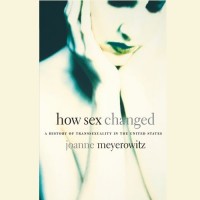Review of Joanne Meyerowitz, How Sex Changed (2002)

©2002, 2013 by Dallas Denny & Taylor & Francis, Inc. The official version of the review is available at Taylor & Francis Online. My scans can be viewed from the button below.
Source: Dallas Denny. (2003, 1 August). Review of Joanne Meyerowitz, How Sex Changed (2002, Harvard University Press). Journal of Sex Research, (40)3, 316-317.
Journal of Sex Research Pages (PDF)
Review of Joanne Meyerowitz, How Sex Changed
By Dallas Denny
I was prepared to dislike JoAnne Meyerowitz’ How Sex Changed, for its title suggested it was a work I would have liked to have written: a history of transsexualism in the United States.From the first page, though, I found myself absorbed—both because the subject is dear to my heart and because Meyerowitz writes in a clear and engaging fashion. I found myself liking her book so much I paced myself, reading it in snatches, two or three pages at a time, so as to be better savor it.
I must admit, I could not find fault with How Sex Changed in regard to scholarship. Meyerowitz, a historian, cites publications and correspondence of which I was unaware—and not just once or twice, but repeatedly, throughout the manuscript. She has unearthed a wealth of obscure citations from hard-to-find sources like Sexology and other popular magazines of the early twentieth century, and she obviously delved deeply into the personal collections of early players like Drs. Harry Benjamin, Robert Stoller, and Virginia Prince, a task that would have taken her across the U.S. at least once, with a side trip to Copenhagen to view the Christine Jorgensen Collection of the Royal Danish Library.
Nor could I fault the book for its perspective. Meyerowitz consistently shows insight and compassion towards all involved: both transsexuals like Reed Erickson, who, through a private foundation, funded much of the early academic work and the first gender identity clinic in the U.S.; and physicians like endocrinologist Harry Benjamin and surgeon Elmer Belt, who sympathized with the plight of transsexuals and aided them when no one else would do so. Meyerowitz acknowledges the struggles of those desperate to change sex in the pre-Jorgensen era and gives credit to the overlooked outreach work of early transsexuals and nontranssexual transgendered individuals like Louise Lawrence—on whom, according to Meyerowitz, both Harry Benjamin and Alfred Kinsey relied for information on transsexualism.
I found the account of the first half of the century particularly useful, as Meyerowitz discusses in detail individuals, events, and publications which have for the most part escaped notice of other scholars—including myself. She even notes the names and gives historical details of those who had early forms of sex reassignment surgery in 1920s Germany.
Meyerowitz traces, among other things, the circumstances which led to the opening of the United States’ first gender clinic at Johns Hopkins, and its eventual closing after the publication of a now-discredited outcome study by Meyer & Reter (1979); the formation of the Harry Benjamin International Gender Dysphoria Association; and the rise of transgender activism.
Initially, I thought the text was biased toward the West Coast, but after reflection I came to the conclusion that it merely lacks the East-coast bias of so many transgender historical texts. Meyerowitz gives equal attention to events in San Francisco and New York. She also avoids the usual bias towards male-to-female transsexualism; full consideration is given to female-to-male transsexualism.
A central theme in How Sex Changed is the change over time in the ways Americans, both transsexuals and nontranssexual, have conceptualized sex and sexuality. Meyerowitz goes into considerable detail on the theory of human bisexuality, which holds that “maleness” and “femaleness” lie on a Likert-like continuum, with few of us on the extreme male or female ends. She traces the theory from its birth in the late 1800s and early 1900s, when “a growing number of scientists in Europe and the United States began to challenge the [then prevalent] notion of separate and opposite sexes” (p. 22), to its peak in the 1950s and 1960s, when it was used by Christine Jorgensen, Harry Benjamin, and others to describe transsexualism: “A 100 per cent man, or a 100 per cent woman does not exist. We all have rudiments of the hermaphrodite (dual sex) state within us” (Jorgensen, 1953, quoted in Meyerowitz, p. 101). Meyerowitz notes that the theory lent itself to the idea that transsexuals were victims of an imbalance both glandular and hence psychological in nature—”lost between the sexes” (Jorgensen’s term, according to Meyerowitz, p. 66). Meyerowitz describes the tensions between the human bisexuality model and the bipolar model favored by psychiatrists, who have traditionally looked upon sex reassignment with disfavor.
If I have a criticism of How Sex Changed, it is that it ends two decades before the close of the century. Meyerowitz checks out around 1980, dedicating but two pages to the tumultuous events of the past 23 years. I can only hope she is preparing a second volume.
Meyer, J., & Reter, D. (1979). Sex reassignment: Follow-up. Archives of General Psychiatry, 36(9), 1010-1015.
